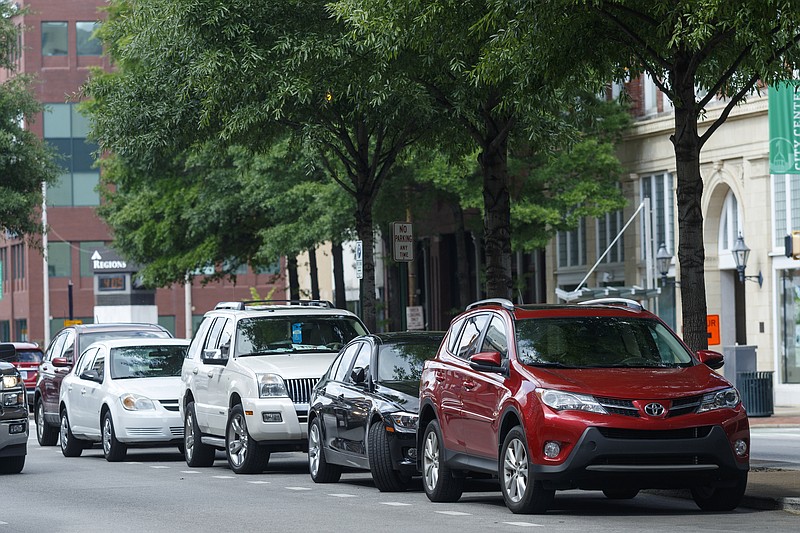What’s next?
* Chattanooga City Council will hold a public hearing Tuesday at 3 p.m. at City Hall on the proposed new formed base code regulations for downtown* The Chattanooga/Hamilton County Regional Planning Commission will consider the formed base code rules for eight downtown properties that were deferred at the commission’s initial hearing last month.* The City Council will make its first vote on the form base code at 6 p.m. on Tuesday, June 14* The City Council is scheduled to make a final decision at the second and third readings of the new form based code at 6 p.m., Tuesday June 21
Find out more
The latest draft of the form base code rules is at www.cha-fbc.com
Open parking spaces
CARTA, which operates more than 2,200 off-street parking garages and lots, estimates on a typical weekday, parking spaces are available throughout the central city.* 1,746 - Spaces usually open in the downtown core* 372 - Spaces on the North shore* 284 - Riverfront Parkway area* 442 - Southside parking spaces
On a typical weekday, CARTA estimates there are usually more than 2,800 off-street parking spaces available in and around downtown at local parking garages and surface lots.
By 6 p.m. and on weekends when the workday ends for most downtown workers, a majority of the more than 16,000 parking spaces in the downtown area usually are open unless there is a major downtown festival, convention or other gathering.
But with thousands more apartment dwellers and downtown workers preparing to live, work or play downtown, Chattanooga's parking landscape is starting to change. Finding the right approach to parking and urban transportation in the central city is one of the most contentious parts of the form-based zoning code the Chattanooga City Council will vote on this month to help define the shape and look of downtown for the future.
To help downtown residents, developers, workers and visitors figure out the best approach to parking in the central city, the Regional Planning Agency conducted a two-hour workshop Thursday night at the Public Library to both inform and involve the public in the parking portion of the new zoning approach. More than 100 community members gathered around a dozen tables to brainstorm, work with blocks and develop their recommendations about how Chattanooga should provide parking in its redeveloping central city.
"We're never going to be able to have the kind of parking arrangements downtown that we do in the suburbs," said Karen Hundt, director of the Planning and Design Studio for the Regional Planning Agency. "With a limited amount of space, we're going to have to think holistically and creatively about parking downtown. But downtown also has a lot more options with buildings closer to one another and many of them with mixed uses and designed for pedestrians or bike riders, in addition to cars."
Chattanooga's downtown has been aided by a number of unique parking and transport features, including the free downtown electric shuttle and its accompanying parking garages - all paid for with federal transit funds and parking fees. More than 900 persons a day typically ride the downtown shuttle to get around the central city.
The city also turned over to its bus system, the Chattanooga Area Regional Transportation Authority, the responsibility for downtown parking in 2012 and the transit agency has worked to create hospitality rates now used by about 400 restaurant and other downtown workers in some of CARTA's parking garages and lots.
The city also added 33 bike share locations two years ago to encourage more downtown bike riding as a form of transport.
The form-base code is an attempt to adapt the changing and different needs for parking and, in most of the 2,900-parcel area covered by the proposed new zoning standards, commercial buildings must have at least one parking space per 1,000 square feet. Form-base code, which is already used in downtown areas of hundreds of other U.S. cities, defines how a building may be built or developed based upon its look, not its usage.
The panels that brainstormed about the parking issue Thursday night recommended setting standards within the form-base code for commercial buildings to guarantee anywhere from 0.75 spaces per 1,000 square feet up to two or more spaces for every 1,000 square feet or building. They also suggested the city add more parking garages, parking apps, free shuttles and covered bicycle parking to help alleviate what many said were growing parking problem downtown.
Bill Glascock, a developer who lives in Fort Wood, said many of his residential neighbors feel like parking is being absorbed by new downtown developments and UTC's expanding student population.
"We need more than one space per 1,000 square feet of commercial space, since that can be taken up by the shop owner and customers and other workers will be looking for parking elsewhere," he said.
Glascock worries that new development will crowd out street-front parking needed for residences in Fort Wood.
"We need to be practical in our approach," he said.
John Bridger, director of the Chattanooga Regional Planning Agency, said the comments from Thursday night's hearing will be compiled and forwarded to the City Council as they try to revamp and or accept the form-based code rules later this month.
Contact Dave Flessner at dflessner@timesfreepress.com or at 423-757-6340.
